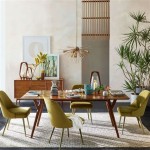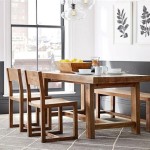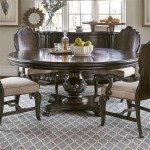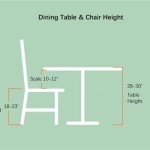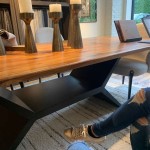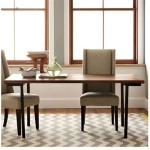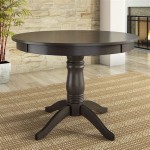Dining Room Table and Sideboard: The Cornerstones of a Dining Space
The dining room, traditionally the heart of the home, serves as a central gathering place for meals, conversations, and celebrations. Two essential pieces of furniture define this space: the dining room table and the sideboard. Their selection and arrangement significantly impact the functionality, aesthetics, and overall ambiance of the dining room.
The dining room table, above all else, is the focal point. It provides a flat surface for eating and can be used for various other activities, such as working, crafting, or playing games. A sideboard, also sometimes referred to as a buffet or credenza, complements the table by offering storage space for tableware, linens, and other dining essentials. Together, these pieces create a cohesive and practical dining environment.
Functionality and Space Considerations
Before selecting a dining room table and sideboard, it's crucial to assess the available space and consider the functional needs of the users. The size of the dining room directly dictates the maximum dimensions of the furniture. A table that is too large can overwhelm a small space, making it feel cramped and uncomfortable. Conversely, a table that is too small in a large room may appear disproportionate and inadequate for hosting gatherings.
The number of individuals who will typically use the dining room is also a critical factor. A smaller, round table might suffice for a couple or a small family, while a larger, rectangular or oval table is better suited for larger families or those who frequently entertain guests. When considering the size, it's essential to allow adequate space around the table for chairs and movement. A general guideline is to leave at least 36 inches between the edge of the table and the walls or other furniture.
The functionality of the sideboard should also be carefully considered. Think about what items need to be stored within it. Is it primarily for storing dishes and silverware? Or will it also serve as a bar area or a space for displaying decorative items? The internal configuration of the sideboard, including the number and type of shelves, drawers, and compartments, should align with the specific storage requirements. Furthermore, the placement of the sideboard is important. It should be easily accessible from the dining table but not obstruct the flow of traffic within the room.
Beyond the size and layout, the functionality is also impacted by the materials used. A table with a heat-resistant surface is better for hot dishes, while scratch-resistant surfaces are preferable in households with children or pets. Similarly, a sideboard with adjustable shelves allows for greater flexibility in accommodating items of varying sizes.
Material and Style Selection
The materials and styles of the dining room table and sideboard significantly contribute to the overall aesthetic of the dining room. The choice of materials affects not only the appearance of the furniture but also its durability and maintenance requirements. Common materials for dining room tables include wood, glass, metal, and stone. Wood is a classic choice, offering warmth and versatility. Different types of wood, such as oak, maple, cherry, and walnut, each possess unique grain patterns and color tones. Glass tabletops provide a modern and minimalist look, while metal tables offer a sleek and industrial feel. Stone tabletops, such as marble or granite, exude elegance and sophistication, but they may also be more expensive and require specialized care.
Sideboards are often constructed from wood, but they can also incorporate other materials like metal, glass, or laminate. The choice of material depends on the desired style and the budget. The finish of the wood also plays a role in the overall aesthetic. A natural wood finish showcases the beauty of the grain, while a painted finish allows for greater customization and the ability to match the furniture to the existing decor.
The style of the dining room table and sideboard should complement the overall style of the home. Common styles include traditional, modern, contemporary, rustic, and eclectic. A traditional dining room might feature a large, ornate wooden table with a matching sideboard adorned with intricate carvings. A modern dining room might opt for a sleek, minimalist glass table with a sideboard featuring clean lines and a glossy finish. A rustic dining room might incorporate a wooden table with a distressed finish and a sideboard made from reclaimed wood. The key is to create a cohesive and harmonious look that reflects the personal preferences and the overall design aesthetic of the home.
The color palette of the furniture is another important consideration. The color should complement the wall color, flooring, and other decorative elements in the dining room. Neutral colors like white, gray, and beige are versatile and can be easily incorporated into various design schemes. Bold colors can add visual interest and personality to the space, but they should be used sparingly and with careful consideration. The hardware on the sideboard, such as the knobs and pulls, should also complement the overall style and finish of the furniture.
Ergonomics and Comfort
While aesthetics are important, the ergonomics and comfort of the dining room table and chairs should not be overlooked. The height of the table should be appropriate for comfortable seating. A standard dining table height is typically between 28 and 30 inches. The chairs should be chosen to ensure that individuals can sit comfortably at the table without feeling too high or too low. The seats should be well-cushioned and provide adequate support. The backrests should also be ergonomically designed to promote good posture.
The legroom under the table is another important factor to consider. The table base should be designed in a way that allows for ample legroom for all occupants. Tables with bulky pedestals or legs positioned too close together can restrict legroom and make the dining experience uncomfortable.
When selecting a sideboard, the height of the surface is also important. It should be at a comfortable height for serving food or drinks. The depth of the sideboard should also be considered to ensure that there is enough space to store all the necessary items without the sideboard protruding too far into the room. The drawers and doors of the sideboard should be easy to open and close, and the shelves should be adjustable to accommodate items of varying sizes.
The texture of the materials used in the dining room table and sideboard can also impact comfort. Smooth surfaces are generally preferred, as they are easier to clean and maintain. However, textured surfaces can add visual interest and provide a more tactile experience. The key is to strike a balance between aesthetics and practicality.
In summary, selecting the appropriate dining room table and sideboard requires careful consideration of functionality, space, style, materials, ergonomics, and comfort. By carefully considering these factors, it is possible to create a dining space that is both beautiful and functional, providing a welcoming and enjoyable environment for meals and gatherings.
Ultimately, the goal is to create a dining room that reflects the individual preferences and lifestyle of the occupants. A well-chosen dining table and sideboard can transform a simple room into a warm and inviting space where memorable moments are created. Careful planning and attention to detail are essential to ensure that these furniture pieces contribute to the overall comfort, functionality, and aesthetic appeal of the dining room.
The longevity of the dining room table and sideboard is also an important consideration. Investing in quality furniture made from durable materials can ensure that these pieces will last for many years to come. Proper care and maintenance are also essential to preserve the beauty and functionality of the furniture. Regular cleaning and polishing can help to prevent damage and extend the lifespan of the furniture.

Dining Room Storage Display Milola Ch

Ers Guide To Dining Room Sideboards And Buffets Countryside Amish

Sideboard And Credenza Ideas Architectural Digest

Ers Guide To Dining Room Sideboards And Buffets Countryside Amish

CasØ 120 Wooden Designer Sideboard White Oak Milola Ch

Dining Room Sideboards Elegant Decorating Ideas

Oslo Solid Oak Dining Furniture Sideboards Large Round Tables

Whitman Extension Wood Dining Table The Joinery

Dining Room Set Stone Creek Haynes Furniture

12 Sensational Dining Room Cabinets For Every Style And Budget

